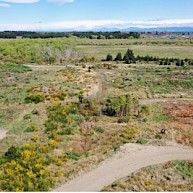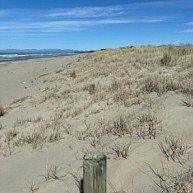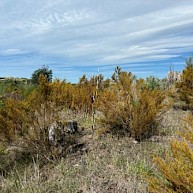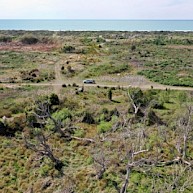This project has been plagued by delays due to Covid, weather and, a fire in 2022. However, the damaged area has been replanted. See this article on RNZ.
Tūhaitara Update March 2025 - David and Michael Bergin
Introduction
Te Kōhaka o Tūhaitara Trust and the Coastal Restoration Trust have been collaborating for the last 4 years in setting up a demonstration restored native coastal forest sequence that is similar to the likely historical dune vegetation cover of north Canterbury. The aim is to progressively replace selected areas of the pines and marginal pasture with native vegetation from foredunes with native sand binders inland to coastal podocarp/hardwood forest.
The Tūhaitara Coastal Park covers 800 ha of coastal land open to the public as a recreational and educational reserve, half an hour north of Christchurch. It is made up of a number of ecosystems including the fore and back dunes, exotic plantation and coastal protection plantings dominated by pines, and the coastal freshwater network made up of a series of wetlands, a lagoon and streams between the Waimakariri River and the township of Pegasus.
This project is building on the long history of work at the park by the Te Kōhaka o Tūhaitara Trust which has a multi-generational 200-year vision to rehabilitate the land to an indigenous coastal ecosystem supporting a diverse range of native flora and fauna species and providing sustainable mahinga kai. Te Kōhaka o Tūhaitara Trust and the Coastal Restoration Trust have worked in partnership for some years. This has included hosting of the Coastal National Conference at Tūhaitara Coastal Park in 2017, pilot planting trials of podocarps on retired pasture, monitoring native sand binding species planted on foredunes, and planting pioneer shrub species on mid and backdunes.
Aims of the project
The aim of the project is to evaluate methods for establishing natives to form a complete coastal sequence from foredunes to inland plains, focusing on restoration of indigenous flora and fauna across the range of forest, wetland, lagoon, estuarine and coastal communities. As with most coastal areas in New Zealand, these intensively settled sites are dominated by urbanisation, intensive agriculture and production exotic forestry.
With the expected impacts of climate change, the vulnerability of our coastal infrastructure to erosion and the ongoing loss of indigenous biodiversity, especially across our most productive working lands, this project will demonstrate how local iwi and community-led action can be achieved to provide a more resilient diverse landscape linking key ecosystems together in a complete coastal sequence.
Coastal sequence trial
Despite significant delays due to Covid-19 Lockdown, the first planting of small groups of natives was undertaken in mid-2021 within a 50 m wide transect from foredune to inland dunes. This included planting of the key native sand binders pīngao and spinifex, as well as sand daphne. Landward within gaps in the pines, groups of native shrub and small tree hardwood and monocot coastal species were planted including ngaio, akeake, tauhinu, tī kōuka, taupata and harakeke.
In addition to the delays due to the pandemic restricting community involvement in planting programmes, the project was significantly impacted by a major fire in November 2022 which burnt 160 ha of Tuhaitara Coastal Park including most of the coastal sequence planting trials established as part of this project. In addition, planting in mid-2022 was delayed due to unusually high rainfall and flooding of dune sites.
Current work
Efforts since the fire involved surveying damage to the plantings, monitoring recovery of vegetation, planning new plantings to get back on track with the establishment of a coastal native forest sequence demonstration area, and organising stock and materials for the 2023 planting season. Immediately after the fire, Trees That Count boosted its support with an additional 10,000 native shrubs and trees. Recently there has been restricted access as logging crews remove burnt pines.
Recent work has focused on the most landward end of the coastal sequence zone which has been clear-felled of pines and prepared for planting coastal native forest. A planting plan based on groves of podocarps including tōtara, mataī and kahikatea, and including appropriate coastal shrub species as a nurse cover, was completed. The design involved the establishment of seed islands within the logged pine area comprising sites up to 20 m in diameter with planting begun in mid-2023.
Preliminary assessments
Allowing for the delays, an assessment of the podocarp seed islands planted at the landward end of the transect had an average 70% survival. All plants had tree protectors and wood chip mulch. Plantings on sites scraped by machine before planting, removing all logging debris, performed more poorly than those amongst slash, leading to recommendations to plant natives amongst logging slash.
At the seaward end of the transect, replacing exotic marram grass with native sand binders has seen high survival of spinifex with some browsing, but pīngao continues to be browsed by rabbits with large losses. Semi-stable inland dunes with group planting of native shrubs amongst the pines suffered initially from drought and then the fire. In the open plots between the cleared pines and the Tūtaepatu Lagoon, plantings are doing better in swales, particularly harakeke and tauhinu than on the more drought-prone sand ridges.
Targeted group plantings, termed ‘biota nodes’, comprising a selected range of coastal native shrubs and small tree species established over the last 10 years by Te Kōhaka o Tūhaitara Trust have been successful, with one biota node located within the mid-dunes of the coastal sequence transect. Some of the biota nodes that were planted within gaps created within the pines have been successful, helped by fencing out rabbits. Interestingly, many of these older biota nodes that included low to moderate-flammability species have survived the fire. Creation of ponds in some biota nodes has also increased species diversity and allowed the release of native mudfish.
Hover over the images below to see their caption
News November 2022
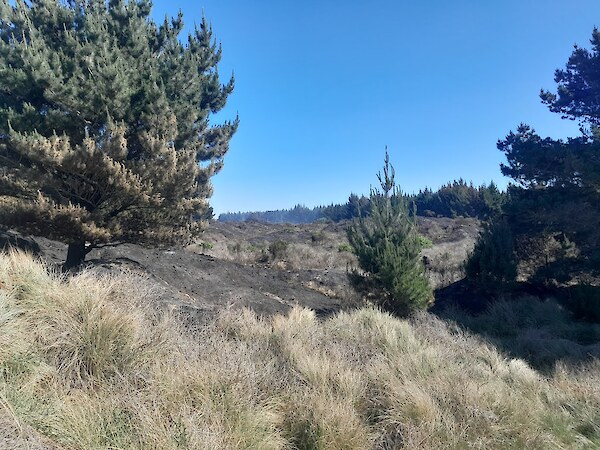 Fire damage in Tūhaitara Coastal Park, North Canterbury
Fire damage in Tūhaitara Coastal Park, North Canterbury
As has been widely reported in the national news, fire swept through more than 200 hectares of coastal pine forest in the Tūhaitara Coastal Park in North Canterbury in early November 2022. This is the site of one of the Coastal Restoration Trust’s planting trials in collaboration with Te Kōhaka o Tūhaitara Trust. It is understood that the fire was started by fireworks at the northern end of the park and travelled south along the coastal dunes fanned by winds in the direction of Woodend Beach.
It has burnt extensive areas of both the protective pine and marram grass dominated frontal dunes and the plantation forests on the backdunes. At one point the campground at Woodend Beach had to be evacuated as helicopters with monsoon buckets and ground based fire crews worked to bring the blaze under control.
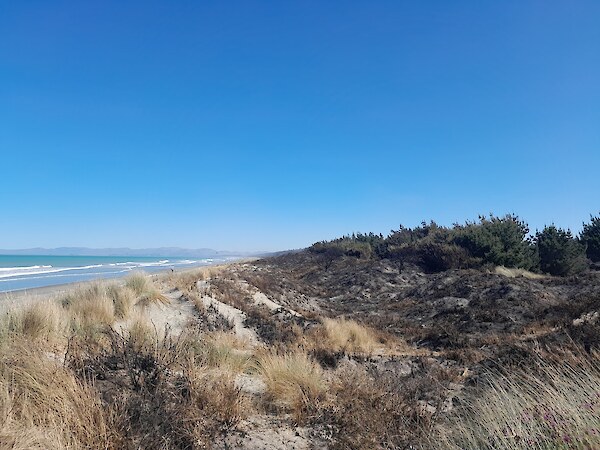 Greg Byrnes, General Manager of Te Kōhaka o Tūhaitara Trust (TKOT), has appreciated the support from the Coastal Restoration Trust and has indicated that “…while it has been a significant event, we have a number of opportunities from the fire. One being that many of our biota node native plantings have come through relatively unscathed. Similarly, at Tūtaepatu Lagoon, while initial views look pretty bad, the tī kōuka, harakeke and aruhe fern will all come back quickly.”
Greg Byrnes, General Manager of Te Kōhaka o Tūhaitara Trust (TKOT), has appreciated the support from the Coastal Restoration Trust and has indicated that “…while it has been a significant event, we have a number of opportunities from the fire. One being that many of our biota node native plantings have come through relatively unscathed. Similarly, at Tūtaepatu Lagoon, while initial views look pretty bad, the tī kōuka, harakeke and aruhe fern will all come back quickly.”
“The only infrastructure we have lost is the lower lookout at Tūtaepatu and around twenty bollards, so this too is not as bad as it could have been. In short, lots of positives, natives resilience over pines, main trails acting as fire breaks, and biota nodes offering seed islands.”
The 3-year coastal sequence planting project, funded by the Department of Conservation’s Community Fund, is aimed at setting up a demonstration site of a restored native coastal forest sequence that was typical of north Canterbury. This project adds and complements the restoration work already underway by TKOT with a multi-generational vision to restore indigenous coastal ecosystems supporting a diverse range of native flora and fauna species and providing sustainable mahinga kai. The project involves replacing logged pines and marginal pasture with foredunes of sandbinders, mid-zone coastal shrublands, wetlands and lagoons, and landward coastal podocarp forest.
COVID-19 lockdown restrictions had postponed earlier plantings particularly where community planting days had to be postponed or cancelled, then flooding in mid-2022 delaying this year’s planting, and now the fire has likely set back progress further.
Greg and his team at TKOT are already working on an action plan which will be ready by the end of the month. The Coastal Restoration Trust will inspect the dune sequence planting trials early in December 2022 where we expect to see many of the first two years of plantings damaged as these sites were in the direct path of the fire. However, we are already collaborating with Greg and with Trees That Count to provide support for new plantings next season.
David Bergin
Trustee, Coastal Restoration Trust of NZ
Update March 2021
Despite several months delay to planning due to Covid-19 Lockdown a planning day was undertaken in June 2020 at the Te Kōhaka o Tūhaitara (TKOT) Rangers Station, Tūhaitara Coastal Park with project partners including TKOT, Waimakariri Council, Coastal Restoration Trust and the DOC contract relationship manager. This included inspection of sites from foredunes to landward and selection of planting areas for demonstration and discussion of site and planting treatments.
A workplan and a report on soil characteristics and topography of the transect was completed.
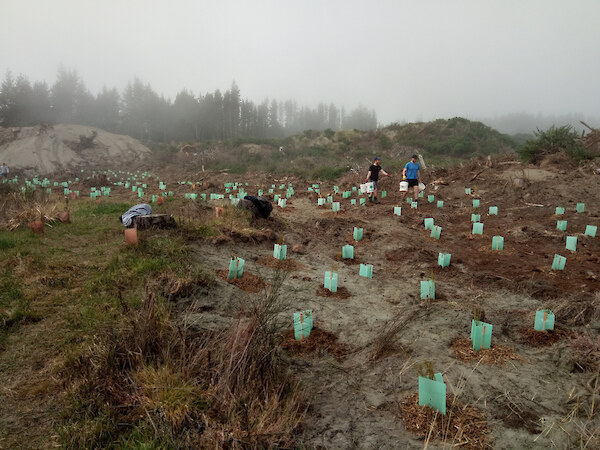 TKOT have completed Year 1 site preparation of part of the coastal sequence site. The first community planting day for this project was undertaken with 100 from the Student Volunteer Army planting over 1000 native trees in August and a further community planting day undertaken in September.
TKOT have completed Year 1 site preparation of part of the coastal sequence site. The first community planting day for this project was undertaken with 100 from the Student Volunteer Army planting over 1000 native trees in August and a further community planting day undertaken in September.
A network of monitoring plots was established to sample across planted sites. Established biota nodes are also being monitored as part of the project to give up to 10 years of growth data on the range of native trees and shrubs planted.
Planning is well underway for the second planting season with a minimum of 5000 native trees, shrubs and sand binding plants within the coastal sequence zone from foredunes to backdunes. The next community planting day is planned for June and further monitoring plots will be established.
Other work has involved the gradual replacement of willows and underplanting with natives, specifically kahikatea to restore the lagoon with indigenous vegetation that supports mahinga kai and spiritual values.
In February 2020 the Trust signed a funding agreement with DOC under their Community Fund, to restore a native forest coastal sequence in Tūhaitara Coastal Park, North Canterbury. Here is a
Summary of the project
OBJECTIVES
- Te Kōhaka o Tūhaitara Trust and Coastal Restoration Trust will set up a demonstration site of a restored native coastal forest sequence that was typical of north Canterbury.
- This 3-year project adds and complements the restoration work already underway by Te Kōhaka o Tūhaitara Trust and their multi-generational vision to restore indigenous coastal ecosystems supporting a diverse range of native flora and fauna species and providing sustainable mahinga kai.
- This involves replacing logged pines and marginal pasture with foredunes of sandbinders, mid-zone coastal shrublands, wetlands and lagoons, and landward coastal podocarp forest.
- A complete coastal vegetation sequence dominated by indigenous flora and fauna will be more resilient to expected impacts of climate change and provide an excellent demonstration area for other coastal communities and landowners in Canterbury and nationwide.
METHODS
- We propose planting and managing a minimum 50 m wide demonstration coastal vegetation sequence linking existing small restoration areas within a high-profile part of the park.
- This builds on the restoration work already underway by Te Kohaka o Tuhaitara including the Tutaepatu Lagoon plantings, the network of biota nodes set up by local schools and community groups, the Pines Beach wetland restoration, planting of sand dunes recently logged of pines with natives, and restoring extensive areas of recently retired pasture.
- A minimum of 5000 native trees, shrubs, ground cover coastal and wetland species will be planted per year across the coastal sequence in collaboration with community volunteers, school and tertiary students, and local service groups.
- Monitoring will involve setting up a series of survival and growth plots on landward sites and point sampling transects on mid and foredune sites in collaboration with volunteer community groups wherever possible supervised by Te Kohako o Tuhaitara and the Coastal Restoration Trust.
- Vegetation monitoring will be integrated wherever possible with monitoring of fauna undertaken in the park including changes in insect, lizard, bird and fish diversity and populations over time.
- Outputs to include guidelines on essential steps to successful restoration of a coastal flora sequence for north Canterbury and recommendations for other coastal sites nationwide.
COLLABORATION
- Collaborating partners include Environment Canterbury, University of Canterbury, Trees That Count, Tāne’s Tree Trust, Waimakariri District Council, and numerous local community and resident associations, service groups, schools, and environmental NGOs.

